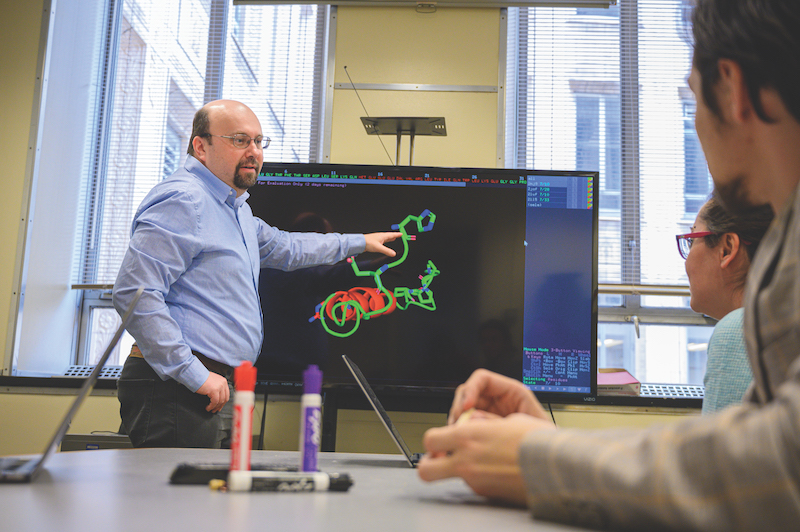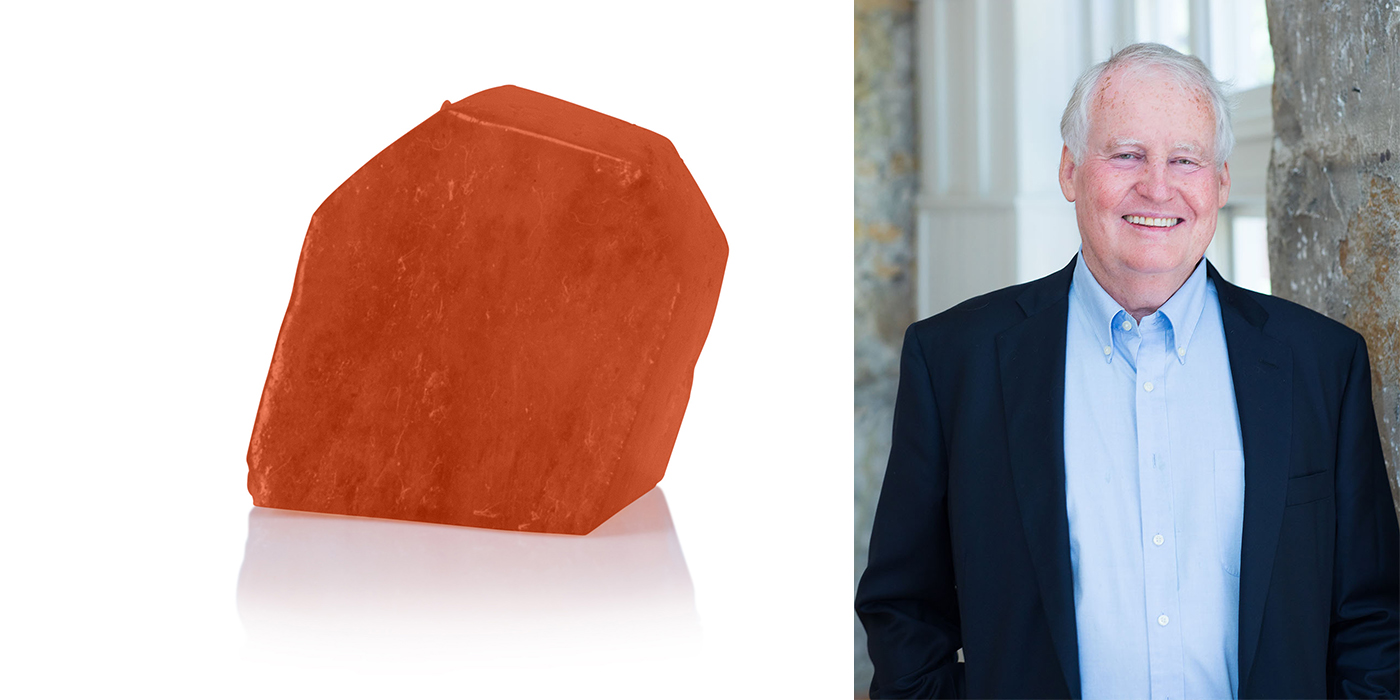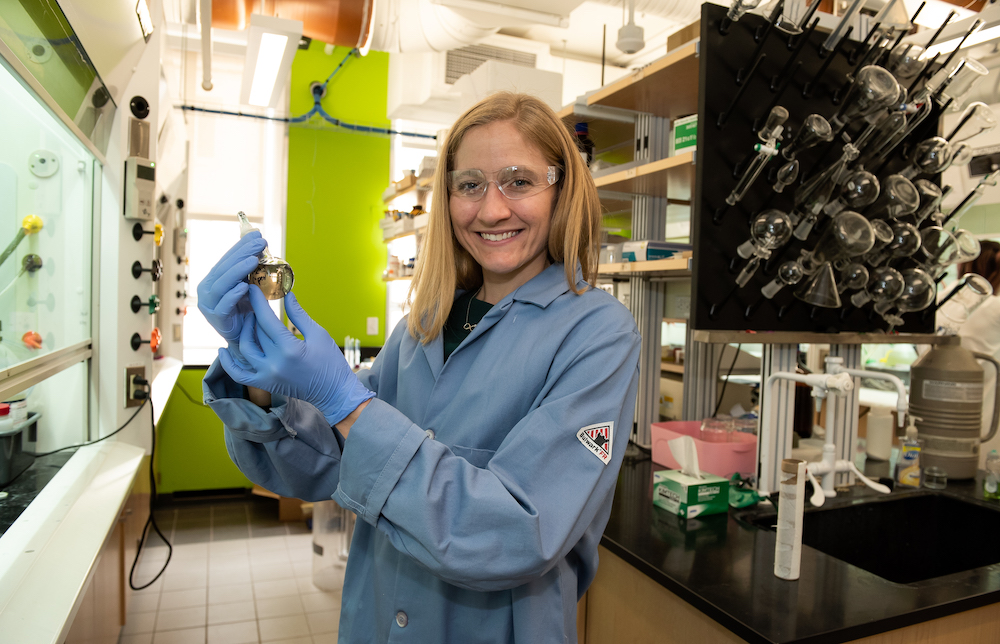

GIZELLE SHERWOOD RECEIVES JULIUS ASHKIN TEACHING AWARD
Assistant Teaching Professor of Chemistry Gizelle Sherwood received MCS’s 2020 Julius Ashkin Teaching Award for her devotion and effectiveness in teaching.
Sherwood is an energetic, creative and enthusiastic teacher who has positively influenced the lives of students both in and outside of the classroom.
Her impact is most apparent in the countless ways she makes herself available to students. Over the years, numerous students have admiringly recounted stories about how she answers Piazza messages within 15 minutes, no matter the hour; held a video call until 2 a.m. to review material; or stayed in her office until 11 p.m. to help a student grasp a new concept. She also has an open-door policy for her office, where students from all her classes come to work, study, and seek advice or a listening ear whenever they need it.
Though Sherwood’s courses have a reputation for being challenging, she constantly empowers her students to succeed. Students credit her meticulous notes, engaging lectures and real- world example problems for helping them digest the difficult material.
When students have a question, Sherwood has a knack for pushing them to draw upon their existing knowledge rather than providing an answer outright, something many students later thank her for. Her supportive yet tough nature emboldens students’ inquisitive minds and helps them become skilled, analytical scholars and researchers.
“Gizelle represents the philosophy of our department, which is to show a genuine concern for students’ success while challenging them appropriately and effectively,” wrote Chemistry Associate Teaching Professor Lenny Vuocolo in nominating her.
Within the department, Sherwood has been invaluable in developing new courses that pull students in from across the university. She co-developed the lab course The Design and Making of Skin and Hair Products, a popular cosmetic chemistry course that has attracted students from five of CMU’s seven schools and colleges.
Beyond teaching, Sherwood regularly offers workshops on macromolecules and water quality at the Gelfand Center, co-teaches a forensics lab to students in the Pennsylvania Junior Academy of Sciences and runs a program for Boy Scouts to earn their chemistry merit badge. Sherwood also uses her personal experiences to mentor and support young women and underrepresented minorities in STEM fields.
Chemistry Professor Receives Grant to Study Material Stability
Assistant Professor of Chemistry Olexandr Isayev has received a $1.7 million grant from the U.S. Department of Defense’s Office of Naval Research as part of a collaborative effort to better understand how organic molecules degrade.
“We plan to develop a computational framework towards predicting degradation pathways and products for a wide range of molecules,” Isayev said of his lab’s role in the project. “This framework will combine fast simulations for degradation pathways, reaction networks and an artificial intelligence engine to help scientists understand the behavior of materials on a molecular level and guide the computational design of future materials.”
Isayev’s lab is collaborating with researchers from the University of Pittsburgh and Purdue University on the project, which was one of 25 selected for this year’s Multidisciplinary University Research Initiative by the U.S. Department of Defense. “It was a natural, perfect fit by three computational chemistry labs with complementary expertise,” Isayev said. “That complementarity allowed us to join forces to tackle this challenging problem.”
Ultimately, Isayev said the team aims to gain a better understanding of how organic molecules and polymeric materials degrade in a variety of different conditions. This will allow future materials to be better designed for stability.
“We will develop tools that chemists and materials scientists could use to predict degradation pathways and products with unprecedented speed and accuracy,” Isayev said.


Carnegie Mellon University Licenses Innovative Green Chemistry Technology
Carnegie Mellon University has announced a licensing agreement with the start-up Sudoc, LLC to market the innovative TAML catalyst technology developed by Teresa Heinz Professor in Green Chemistry Terrence J. Collins.
Collins, the head of Carnegie Mellon’s Institute for Green Science, has for over three decades led the work on developing TAML catalysts. Together with his teams, Collins has made a series of breakthroughs that have resulted in a family of catalysts that have the remarkable oxidation capabilities needed to remove harmful chemicals from the environment and then vanish once their work is done.
“Given the ever-expanding number of toxic chemicals in common use today (over 300,000) and the large number of chemicals that don’t degrade and persist in our ecosystem for decades, I am delighted to see Sudoc introducing new products that can outperform these toxic chemicals but disappear when their work is done,” said Collins, who co-founded Sudoc.
“Carnegie Mellon University has supported an incredible body of research into a sustainable chemistry that could revolutionize how we think about a wide range of products and services,” said Roger Berry, CEO and co-founder of Sudoc. “We can look forward to a wide and expanding array of opportunities, ranging from the creation of new cleaning products to the development of new environmental treatment solutions. The potential for this technology to transform the planet for the better is astonishing.”
“Carnegie Mellon is proud to support Dr. Collins and his teams and is delighted to find a group of investors and entrepreneurs in Sudoc so well-suited to carrying out the commercialization efforts needed to bring this remarkable chemistry to market,” said Robert Wooldridge, Carnegie Mellon’s associate vice president and head of the Center for Technology Transfer and Enterprise Creation. “This invention has incredible commercial promise, but, even more importantly, TAML catalysts can reverse the adverse impact of toxic chemicals on living beings.”
Sudoc was formed in 2020 with operations in Cambridge, Massachusetts, Charlottesville, Virginia, and Pittsburgh and is developing a range of products that will, among other applications, treat mold, clean wastewater and mineralize waste pharmaceuticals. By outperforming other technologies that currently perform these functions, Sudoc’s products will help to remove these harmful chemicals from our planet. To guarantee its commitment to the public good, Sudoc’s largest shareholder is a pair of trusts that will over time fund research into the problem of endocrine disrupting chemicals — toxic chemicals that disrupt the hormone systems of living beings, reducing human fertility, inducing diseases and adversely affecting behavior.
Danith Ly Receives Grant to Develop Global Pathogen Surveillance System
Professor of Chemistry Danith Ly has received a $500,000 grant from the DSF Charitable Foundation and the Mellon College of Science to take the early steps in developing a Global Pathogen Surveillance System (GPS2) that will integrate molecular circuits with existing telecommunications technology to identify potential hotspots for the emergence of infectious diseases.
Most pandemics, including the bubonic plague, Spanish flu and COVID-19, are caused by pathogens, specifically viruses or bacteria. The same holds true for a number of deadly diseases, including smallpox, influenza, malaria and cholera. When these diseases and their associated pandemics are stopped by the development of effective treatments and vaccines, the pathogens don’t simply vanish. Rather they jump from humans to livestock and cohabitated organisms, where they replicate and mutate until the conditions are right for them to return. With each round, infections become more widespread and evasive to modern deterrents due to the bacteria and viruses’ newly acquired genetic immunity.
“We want to build something like the Tsunami Warning System for pathogens,” said Ly, who is the director of Carnegie Mellon’s Institute for Biomolecular Design and Discovery. “If we can detect an uptick in the presence of a pathogen in a localized environment, we can warn those who are likely to be infected. This will afford them time to take potentially life-saving precautions that will prevent outbreaks and pandemics from starting.”
Ly has been developing a molecular circuit that scientists, field workers or even the general population could easily and inexpensively use to test water, soil or insects for deadly pathogens. For example, a person could take a few drops of water or a dead mosquito, place it in a vial and add a few drops of a solution that contains the molecular circuit. The circuits can detect genetic sequences unique to a given pathogen and convert and amplify the sequence so they emit a reporter signal that is revealed using UV light. The person could then take a picture of the sample using a smart phone and send it to a command center, where the information will be processed and disseminated with the aid of artificial intelligence. If the command center receives an influx of signals indicating a given pathogen in one area, it could then alert local residents and officials of the potential for an outbreak.
Ly is also developing the molecular circuit to be able to detect the presence of pathogens in saliva or blood samples from humans, making it a possible tool for diagnosing and tracking the path of a disease during a pandemic.
Central to the development and implementation of GPS2 are the unique characteristics of the integrated circuit that Ly developed, called In-situ Nucleic Acid Detection and Signal Amplifications (or INDSA), which allow for testing without sample preparation, enzyme-based target or signal amplification, or complicated instrumentation.
“In the case of an emergent epidemic like the early stages of COVID-19, the molecular circuits could also be used for rapid, on-site mass-population screenings. Having the ability to do this could prevent an epidemic from becoming a pandemic,” Ly said.
With the funding from DSF and MCS, Ly plans to continue to develop and refine the integrated INDSA detection prototype. He also will work with computer scientists and system engineers to develop the infrastructure for acquiring and transmitting data from the GPS2.


Stefanie Sydlik Honored as One of World’s Best Young Scientists
Associate Professor of Chemistry Stefanie Sydlik was recognized as one of the world’s leading young scientists in 2020 by the World Economic Forum.
Sydlik, a 2007 Mellon College of Science graduate, synthesizes innovative new polymers for biological uses in her Carnegie Mellon lab. By modifying graphite with calcium phosphate, for example, her lab has been able to turn the material found in pencil lead into a scaffold that can be used to help heal traumatic bone injuries and then naturally degrade away. In a similar vein, her lab has also worked to develop additives for medical adhesives that can allow those adhesives to carry small molecule drugs such as analgesics for pain or anti-inflammatories.
Annually, the World Economic Forum selects a class of rising-star scientists under the age of 40 from a wide range of fields to connect them with world leaders and help solve major issues.
“I’m really excited to be involved in this global network and to be in a group where we can talk about the big problems and affect policy going forward,” Sydlik said of the honor. In particular, she said she’s hoping to engage with non-scientists from around the world and learn about the problems they hope scientists will work to solve.
One particular issue Sydlik is interested in tackling is microplastics, minute fragments of plastic that can accumulate in the environment and affect animals and even humans.
Sydlik joined the faculty at Carnegie Mellon in 2015 after completing a postdoctoral fellowship in chemical engineering and a Ph.D. in organic chemistry at MIT. As an MCS undergraduate, she was selected as a Beckman Scholar in 2006 and received the 2007 Judith A. Resnik Award.
